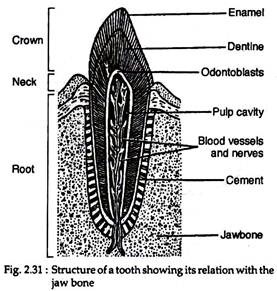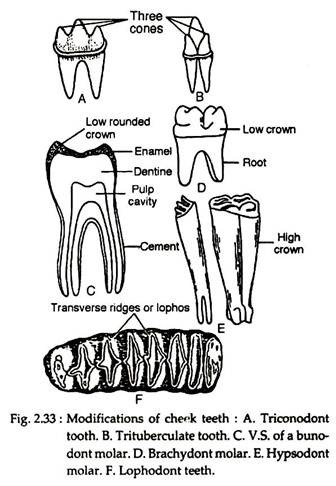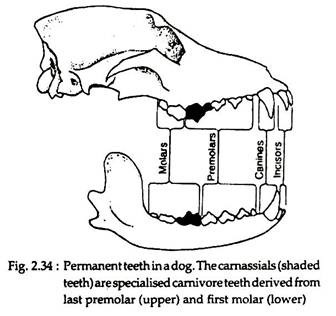In this article we will discuss about:- 1. Origin and Structure of Teeth 2. Absence of Teeth 3. Types.
Origin and Structure of Teeth:
Teeth have evolved from denticles which are released from armour near the margins of the mouth as ossification in the integument. A typical mammalian tooth can be distinguished mainly into two regions — crown and root.
The crown is the exposed part of the tooth and situated above the root and in the old age it is generally subject to wear. The root is the hidden part in the gum which is anchored in the socket or alveolus of the jaw bone. The tooth encloses a pulp cavity that contains blood vessels, nerves and connective tissue (Fig. 2.31).
The junction of crown and root is called neck. There are three kinds of tissues in a typical tooth. These are enamel, dentine and cement. Crown is covered by a thin, very hard, glistening layer, called enamel.
ADVERTISEMENTS:
It is the hardest and heaviest tissue of the vertebrates and is composed of crystals of hydroxyapatite [(Ca3PO4)2-Ca (OH)2]. It is ectodermal in origin and totally acellular. Below enamel, a hard dermal bony substance layer is found, called dentine.
It is harder than bone but softer than enamel. The root of tooth is covered by a thin layer of cement and a vascular periodental membrane of strong connective tissue fibres (Sharpey’s fibres) cement. Cement is a nonvascular bone and usually acellular.
It is softer than dentine and is rich in collagenous fibres. It wears rapidly when exposed. The pulp cavity is lined by a layer of bone cells called odontoblasts. Both dentine and cement are mesodermal in origin.
Absence of Teeth:
ADVERTISEMENTS:
Teeth are present in all mammals though a secondary toothless condition is found in some mammals. The adult platypus (Ornithorhynchus) bears epidermal teeth but no true teeth are present. In platypus embryonic teeth are replaced by horny epidermal teeth in adult.
In echidna or spiny ant-eater (Tachyglossus) the teeth are absent in all stages of life. In certain ant-eaters (e.g. Myrmecophaga, Tamandua and Cyclopes) and in adult Balaena (Right whale), Caperea (Pygmy right whale), Eschrichtius (Grey whale), Balaenoptera (Rorqual whale), Megaptera (Humpback whale) teeth are absent.
ADVERTISEMENTS:
Types of Teeth:
In heterodont condition teeth can be distinguished into 4 types. These are incisors, canines, premolars and molars (Fig. 2.34).
(i) Incisors:
These are situated anteriorly on the premaxilla in upper jaw and tips of dentaries in lower jaw. These are conical, single-rooted and monocuspid. These are used for cutting or cropping. Incisors may be totally absent in sloth or absent on the upper jaw in sheep and ox. In rodents and lagomorphs, the incisors are chisel-shaped, open-rooted and continue to grow throughout life.
(ii) Canines:
Canines lie immediately behind the incisors. These are single in each half of the jaw. These are large-pointed, long-crowned with a single root. In rodents and lagomorphs, the canine is absent, leaving a space in-between incisors and premolars, called diastema.
Any gap within the dental series is called diastema. In horses, the canines are relatively small. In carnivores (dogs, tigers and lions) the canines become spear-shaped and are used for piercing and tearing the flesh. They are generally used for holding and piercing in relation to both feeding and fighting.
ADVERTISEMENTS:
(iii) Premolars:
Following the canines there are premolars or bicuspid teeth. These have two roots and two cusps. The premolars are used for grinding the food material.
(iv) Molars:
Molars lie behind the premolars. These have two or more roots and several cusps. Molars are used for crushing food. Premolars and molars are collectively called cheek teeth. In carnivores the number of cheek teeth is often reduced and in some cases (Fissipedia) last upper premolar and first molar in lower jaw are modified into chisel-shaped sharp cusps, called carnassial teeth used for cracking bones and shearing tendons. The last molar of man is called wisdom tooth and its eruption is often delayed (Fig. 2.34).
(v) Cusp patterns of cheek teeth:
The molars contain many cusps on their surface. Depending on the number and shape of the cusps, molars are recognised in different names:
(vi) Triconodont:
In this condition, molars possess three cones or cusps arranged in an anteroposterior lines. This type of molar teeth are found in the fossil Mesozoic mammals (Fig. 2.33A), e.g. Triconodon.
(vii) Trituberculate:
Here the molars contain three cones or tubercles, arranged in the form of a triangle (Fig. 2.33B). It also found among fossil Mesozoic mammals, e.g. Spalacotherium. Depending upon the feeding habit and the type of food taken (trophic specialisation), the premolars and molars of recent eutherians have undergone changes in their shape and cheek teeth are recognised into the following names:
(viii) Bunodont:
When the cusps in the cheek teeth remain separate and rounded, the tooth is called bunodont (mound + tooth). In man and in some omnivore mammals the cheek teeth are bunodont type and these are used in grinding the food material (Fig. 2.33C).
(ix) Lophodont:
If the cusps are joined to form ridges or lophs, the tooth is called lophodont. The cheek teeth of elephant is of lophodont type. There is an intricate folding of enamel and dentine (Fig. 2.33F). These type of teeth are used to grind all sorts of plants, and also grasses.
(x) Secodont:
When the cheek teeth are with sharp cutting crowns, the teeth are called secodont. This condition of teeth is present in terrestrial carnivores. These teeth possess cutting edges and are used for cutting and shearing the flesh.
(xi) Selenodont:
Cheek teeth with crescent shaped cusps are known as selenodont. In ruminants and horses (perissodactyla), the teeth are selenodont type and are used for grinding the plant matter.
(xii) Brachydont:
A tooth with a low crown and comparatively long root is called brachydont (Fig. 2.33D) e.g. man.
(xiii) Hypsodont:
When the crown is high and the roots are short and open (Fig. 2.33E), e.g. horse, incisor of elephants etc.
(xiv) Dental formula:
The number of teeth in any particular species remains constant but varies in different species. So the number of teeth are expressed by a sort of equation called dental formula. The maximum number of teeth in heterodont mammals are 44. There are mammals with teeth less than 44. This is due to the reduction in the number of one or more types.
This constancy in the number of teeth has become a tool to the taxonomists for the purpose of classification. The dental formula is expressed by the number of each type of tooth in each half of the upper and lower jaws. The teeth of the upper jaw are placed as numerators and of the lower jaw as denominators.
The numerators and denominators are separated by a horizontal line. The kind of teeth is indicated by initial letters i, c, pm, m indicating incisor, canine, premolar and molar, respectively. For further simplification, the initial letters are often omitted. When a certain type of tooth is absent, a zero is used to indicate the fact.
Dental formula of some mammals:
A typical primitive eutherian mammal possesses 44 teeth and it is expressed
i3/3, c1/1, pm4/4, m3/3 = 22 × 2 = 44
In simpler forms it may be expressed as
3.1.4.3/3.1.4.3 = 11/11 = 22 × 2 = 44
Among monotremes, Tachyglossus does not possess teeth at any stage. The adult platypus (Ornithorhynchus) bears no teeth.
In marsupials the milk dentition persists except the last premolar. In adult marsupials the number of incisors in upper and lower jaws always vary except in burrowing wombats (Phascolomys).
Kangaroo (Macropus) 3.1.2.4/1.0.2.4 = 10/7 = 17 × 2 = 34
American opossum (Didelphys) 3.1.4.3/3.1.4.3 = 11/11 = 21 × 2 = 42
Family Suidae (e.g. pigs and horses) bears primitive eutherian type of teeth.
Horse and pigs 3.1.4.3/3.1.4.3 = 11/11 = 22 × 2 = 44
(xv) Unusual specialised teeth:
(a) Elephant’s tusk:
The elephant’s tusks are the second pair of incisors in the upper-jaw. The lower incisors disappeared. The tusks are made of ivory which is a specialised dentine. The upper incisors have no root and they grow to form tusk. Both sexes of African elephants have tusks but in India only males bear tusks. Tusks are used in offence and defense.
(b) Pig’s tusk:
In wild boar the upper canines are enlarged to form stout tusks. The warthog (Phacochoerus) of Africa bears 4 upward curving tusks. These are transformed canines of both jaws. These are used for digging in the soil for underground storage roots and tubers of the plants, which are their food.
(c) Barking deer’s tusk:
The male muntjaks possess tusks which are the enlarged form of canine teeth.
(d) Walrus’s tusk:
These are the modified form of upper canines. The primary function of the tusks is to break the clams on the ocean floor.


